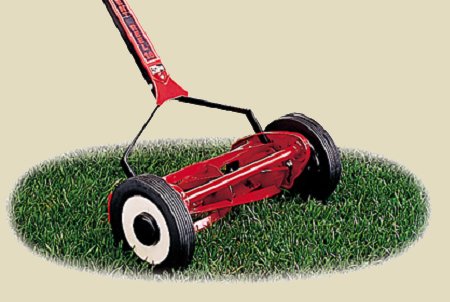Mowing Tips
 Proper mowing is one of the most important aspects of turf cultural practice, yet it is one of the least respected. Mowing contributes to strong root development, plant vigor, and weed and disease control. While each turf grass has different mowing requirements, there are some general rules to follow.
Proper mowing is one of the most important aspects of turf cultural practice, yet it is one of the least respected. Mowing contributes to strong root development, plant vigor, and weed and disease control. While each turf grass has different mowing requirements, there are some general rules to follow.
- Mow regularly. Mow often enough so that you are not removing more than 1/3 of the blade mowing height at each mowing (See Below). Normally once a week is fine for most turf grasses but at times of rapid growth you may have to mow every five days or so to accomplish this.
- Never take off more than 1/3 of the blade in any one mowing. "Scalping" a lawn like this weakens the grass plant and promotes shallow rooting. If the lawn gets very high you may have to take it down gradually waiting about 3 days in-between mowings as you lower the mower from its highest position.
- Use a sharp blade. Grass blades shredded by a dull mower blade have an off-color appearance and can allow diseases to enter through the ragged edges. When mowing Bermuda, Fescue or Blue grasses sharpening the blade about twice a year, or every 10-15 mowing hours should suffice. If you have a Zoysia grass, Centipede grass or St. Augustine grass you should sharpen even more often.
- Vary mowing patterns. Consistently mowing the grass in the same direction will cause it to begin to lay flat taking away from its appearance. You can avoid "training" the grass to go in one direction by alternating your mowing pattern weekly. One week you can go up and down and then the next week change the pattern to go from side to side.
- Do not bag the clippings. Unless the lawn is seriously overgrown or you are purposely scalping (e.g. Bermuda grass at the beginning of spring, Fescue grass just prior to aeration and seeding in fall), let the clips fall where they may. Clippings have not been shown to contribute to thatch and they contain moisture and nutrients that the turf needs.
- Remember to cut at the correct mowing height for your particular turf. Grasses like to be at a certain length and will function poorly if cut too short or left too long. Cutting turf too short deprives the grass of stored nutrients, encourages weak rooting, promotes weed pressure and takes away color. Mowing too high can also encourage weak rooting and contribute to thatch in warm season lawns. Please refer to your type of grass below.
Suggested mowing height for some of the more popular Turf Grasses:
- Tall Fescue 3"- 4" The warmer the climate the taller this grass can be cut.
- Bermuda 1.0" - 2.5" Grass should end the season higher than it begins it.
- Bluegrass/Rye 1.0"-2.5"
- Zoysia 0.5"-2.0"
- Centipede 1.0"-2.0"
- St. Augustine 1.5"-3.0"
Source for parts of this table:Principles of Turfgrass Management, The University of Georgia
About the Author
For over three decades, King Green has been dedicated to revolutionizing lawn care. Our journey began with a vision to create greener, healthier lawns. Beautifully maintained grass in Mcdonough, GA Over the years, we have honed our expertise, leading to countless success stories of transforming ordinary lawns into vibrant landscapes. Our commitment to innovation and quality has been the driving force behind our history of excellence in lawn care service.
